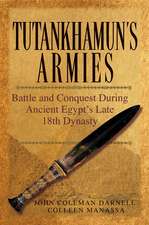The Late Byzantine Army – Arms and Society, 124–1453: The Middle Ages Series
Autor Mark C. Bartusisen Limba Engleză Paperback – 31 dec 1996
Din seria The Middle Ages Series
-
 Preț: 195.13 lei
Preț: 195.13 lei -
 Preț: 192.05 lei
Preț: 192.05 lei -
 Preț: 281.27 lei
Preț: 281.27 lei -
 Preț: 193.04 lei
Preț: 193.04 lei -
 Preț: 198.22 lei
Preț: 198.22 lei -
 Preț: 240.85 lei
Preț: 240.85 lei -
 Preț: 294.22 lei
Preț: 294.22 lei - 19%
 Preț: 509.33 lei
Preț: 509.33 lei -
 Preț: 245.45 lei
Preț: 245.45 lei -
 Preț: 232.87 lei
Preț: 232.87 lei -
 Preț: 286.76 lei
Preț: 286.76 lei -
 Preț: 192.05 lei
Preț: 192.05 lei -
 Preț: 323.44 lei
Preț: 323.44 lei -
 Preț: 231.78 lei
Preț: 231.78 lei -
 Preț: 183.69 lei
Preț: 183.69 lei -
 Preț: 216.43 lei
Preț: 216.43 lei - 19%
 Preț: 420.72 lei
Preț: 420.72 lei -
 Preț: 267.27 lei
Preț: 267.27 lei - 23%
 Preț: 538.83 lei
Preț: 538.83 lei -
 Preț: 285.64 lei
Preț: 285.64 lei -
 Preț: 248.56 lei
Preț: 248.56 lei -
 Preț: 197.18 lei
Preț: 197.18 lei -
 Preț: 230.41 lei
Preț: 230.41 lei -
 Preț: 243.06 lei
Preț: 243.06 lei -
 Preț: 247.43 lei
Preț: 247.43 lei -
 Preț: 191.00 lei
Preț: 191.00 lei -
 Preț: 154.43 lei
Preț: 154.43 lei -
 Preț: 199.23 lei
Preț: 199.23 lei -
 Preț: 317.31 lei
Preț: 317.31 lei -
 Preț: 285.64 lei
Preț: 285.64 lei - 19%
 Preț: 446.65 lei
Preț: 446.65 lei -
 Preț: 285.88 lei
Preț: 285.88 lei -
 Preț: 406.68 lei
Preț: 406.68 lei -
 Preț: 191.00 lei
Preț: 191.00 lei -
 Preț: 216.36 lei
Preț: 216.36 lei -
 Preț: 192.05 lei
Preț: 192.05 lei -
 Preț: 290.05 lei
Preț: 290.05 lei -
 Preț: 458.15 lei
Preț: 458.15 lei - 30%
 Preț: 406.56 lei
Preț: 406.56 lei -
 Preț: 232.58 lei
Preț: 232.58 lei - 19%
 Preț: 363.86 lei
Preț: 363.86 lei -
 Preț: 198.22 lei
Preț: 198.22 lei -
 Preț: 322.52 lei
Preț: 322.52 lei -
 Preț: 405.32 lei
Preț: 405.32 lei - 19%
 Preț: 391.74 lei
Preț: 391.74 lei -
 Preț: 243.06 lei
Preț: 243.06 lei -
 Preț: 428.40 lei
Preț: 428.40 lei - 19%
 Preț: 415.73 lei
Preț: 415.73 lei -
 Preț: 239.77 lei
Preț: 239.77 lei
Preț: 326.74 lei
Nou
Puncte Express: 490
Preț estimativ în valută:
62.53€ • 65.11$ • 52.85£
62.53€ • 65.11$ • 52.85£
Carte disponibilă
Livrare economică 14-28 februarie
Preluare comenzi: 021 569.72.76
Specificații
ISBN-13: 9780812216202
ISBN-10: 0812216202
Pagini: 464
Dimensiuni: 152 x 229 x 33 mm
Greutate: 0.77 kg
Ediția:Revised
Editura: MT – University of Pennsylvania Press
Seria The Middle Ages Series
Locul publicării:United States
ISBN-10: 0812216202
Pagini: 464
Dimensiuni: 152 x 229 x 33 mm
Greutate: 0.77 kg
Ediția:Revised
Editura: MT – University of Pennsylvania Press
Seria The Middle Ages Series
Locul publicării:United States
Textul de pe ultima copertă
Mark C. Bartusis opens an extraordinary window on the Byzantine Empire during its last centuries by providing the first comprehensive treatment of the dying empire's military. The late Byzantine period was a time characterized by both civil strife and foreign invasion and framed by two cataclysmic events: the fall of Constantinople to the western Europeans in 1204 and again to the Ottoman Turks in 1453. While the army enjoyed a highly visible presence during this time, it was increasingly ineffective in defending the state. This failure is central to understanding the persistence of the western European crusader states in the Aegean, the advance of the Ottoman Turks into Europe, and the slow decline and eventual fall of the thousand-year Byzantine Empire. Using all of the available Greek, western European, Slavic, and Turkish sources, Bartusis describes the evolution of the army both as an institution and as an instrument of imperial policy. He considers the army's size, organization, administration, and varieties of soldiers, including discussions of campaigns, garrisons, finances, recruitment, and the military role of peasants, weapons, and equipment. He also examines Byzantine feudalism and the army's impact on the economy and society. Bartusis emphasizes that the corps of heavily armed mercenaries and soldiers probably never numbered more than several hundred. He further argues that the composition of the late Byzantine army had many parallels with the contemporary armies in western Europe, including the extensive use of soldier companies composed of foreign mercenaries. In a final analysis, he suggests that the death of Byzantium is attributable more to a shrinking fiscal base thanto any lack of creative military thinking on the part of its leaders. The Late Byzantine Army is a major work of scholarship that fills a gap in the understanding of the late Byzantine empire. It will be of interest to students and scholars of medieval and Byzantine institutional history.















